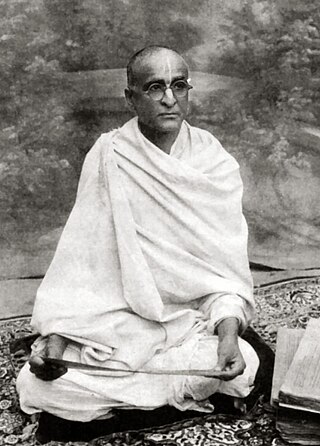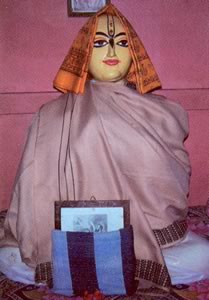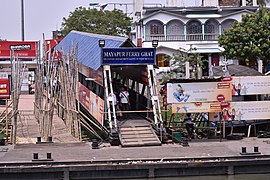
Chaitanya Mahaprabhu, born Vishvambhara Mishra, was an Indian Hindu saint from Bengal and the founder of Gaudiya Vaishnavism. Chaitanya Mahaprabhu's mode of worshipping Krishna with bhajan-kirtan and dance had a profound effect on Vaishnavism in Bengal.

Bhaktisiddhanta Sarasvati, born Bimala Prasad Datt, was an Indian Gaudīya Vaisnava Hindu guru, ācārya, and revivalist in early twentieth-century India. To his followers, he was known as Srila Prabhupāda.

Nityananda, also called Nityananda Prabhu and Nitai, was a primary religious figure within the Gaudiya Vaishnava tradition of Bengal. Nityananda was Chaitanya Mahaprabhu's friend and disciple. Chaitanya and Nityananda are often mentioned together as Gaura-Nitai or Nimai-Nitai.

Gaudiya Vaishnavism, also known as Chaitanya Vaishnavism, is a Vaishnava Hindu religious movement inspired by Chaitanya Mahaprabhu (1486–1534) in India. "Gaudiya" refers to the Gaura or Gauḍa region of Bengal, with Vaishnavism meaning "the worship of Vishnu". Specifically, it is part of Krishnaism—Krishna-centric Vaishnavite traditions.
Narottama Dasa Thakura, also known as Thakura Mahasaya, was a Gaudiya Vaishnava saint who spread Vaishnava bhakti throughout Odisha, in Bengal, and elsewhere in India. Narottama Dasa was the son of King Krishnananda Datta and Narayani Devi, who resided in Gopalpur Pargana of the modern-day Rajshahi district of Bangladesh. According to some scriptues, after the death of his father he entrusted his royal duties to the eldest son of his paternal uncle and left for Vrindavana.

Bhaktivinoda Thakur, born Kedarnath Datta, was an Indian Hindu philosopher, guru and spiritual reformer of Gaudiya Vaishnavism who effected its resurgence in India in late 19th and early 20th century and was called by contemporary scholars as a Gaudiya Vaishnava leader of his time. He, along with his son Bhaktisiddhanta Sarasvati, is also credited with initiating the propagation of Gaudiya Vaishnavism in the West and its global spread.
Krishnadasa, known by the honorific Kaviraja, was the author of the Chaitanya Charitamrita, a biography on the life of the mystic and saint Chaitanya Mahaprabhu (1486–1533), who is considered by the Gaudiya Vaishnava school of Hinduism to be an incarnation of Radha and Krishna combined.
The Chaitanya Charitamrita, composed by Krishnadasa Kaviraja in c. 1557, is written in Bengali with a great number of Sanskrit verses in its devotional, poetic construction, including Shikshashtakam. It is one of the primary biographies detailing the life and teachings of Caitanya Mahāprabhu, the founder of Gaudiya Vaishnavism. The stories of Chaitanya's life are mixed with philosophical conversations detailing the process of Bhakti yoga, with special attention given to congregational chanting of the names of Krishna.

Rupa Goswami was a devotional teacher (guru), poet, and philosopher of the Gaudiya Vaishnava tradition. With his brother Sanatana Goswami, he is considered the most senior of the Six Goswamis of Vrindavan associated with Caitanya Mahaprabhu, a hidden avatar (incarnation) of Krishna in Kali Yuga.
Sanatana Goswami was a principal follower of Chaitanya Mahaprabhu. Sanatana wrote a number of works in the bhakti tradition of Gaudiya Vaishnavism and was the senior most of the influential Six Goswamis of Vrindavan, among whom was his brother Rupa Goswami.

Ekachakra is a small village, located 20 km away from the town of Rampurhat in the Birbhum District of West Bengal. Within Hindu tradition, the five Pandavas from the epic, Mahabharata are described as staying in Ekachakra during their years in exile. It is also famous as the birthplace of Nityananda Rama, a principal religious figure in the Gaudiya Vaishnava tradition.

The Pancha Tattva, in the Gaudiya Vaishnavism tradition of Hinduism, are five 15th-century religious figures, venerated as the five aspects of the god Krishna.

Nabadwip, also spelt Navadwip, anciently Nadia or Nudiya, is a heritage city in Nadia district in the Indian state of West Bengal. It is regarded as a holy place by Hindus, and is the birthplace of Chaitanya Mahaprabhu. Famous for Rass festival where city is illuminated with lights, deities of God and goddesses are made on each corner of Nabadwip town. Hundreds of people gather to this small town on the occasion of raas utsab. Located on the western bank of the Hooghly River, it is considered to have been founded in 1063 CE, and served as the old capital of the Sena dynasty. A center of learning and philosophy in medieval India, the city is still noted for its traditional Sanskrit schools. The Navya Nyaya school of logic reached its peak with the efforts of some well known contemporary philosophers of Nabadwip. The great Vaishnava saint, social reformer and an important figure of the Bhakti movement, Chaitanya Mahaprabhu (1486–1534) was born here. It was after Chaitanya Mahaprabhu's birth that Nabadwip became an important center of pilgrimage for the Vaishnavas worldwide as well as for Hindus in general. Many who follow Gaudiya Vaishnavism visit Nabadwip to celebrate the auspicious birthday day of Shri Mahaprabhu, which, as per lunar calculations, occurs on Phalguni Purnima. This day is commonly known as Gaura-purnima. Aside from this, Nabadwip is visited for various other festivals like Dol Jatra and Rash purnima.

Gadadhara Pandita, also known as Pandita Goswami, was a close childhood friend of Chaitanya Mahaprabhu, the founder of the Hindu tradition of Gaudiya Vaishnavism.

Gaura Purnima is a Vaishnava festival that celebrates the birth of Chaitanya Mahaprabhu (1486–1534), who founded Gaudiya Vaishnavism. It occurs on the purnima in the Hindu month Phalguna, usually falling in March or April.

Haridasa Thakur was a Vaishnava saint known for playing a part in the initial propagation of Gaudiya Vaishnavism. He is considered to be a known convert of Chaitanya Mahaprabhu, along with Rupa Goswami and Sanatana Goswami. His story of integrity and faith in the face of adversity is told in the Chaitanya Charitamrita. It is believed that Chaitanya Mahaprabhu himself designated Haridasa as nāmācarya, meaning the 'teacher of the Name'. Haridasa Thakura was a devotee of the deity Krishna, and is regarded to have practised the chant of his veneration, the Hare Krishna mantra, 300,000 times daily.

Jahnava Devi ; c. 1481 – c. 1541), also called Jahnava Mata, was the wife of Nityananda and a philosopher and saint from the Gaudiya Vaishnava school of Hindu Vedanta. She became a leading figure in Gaudiya Vaishnavism and a diksa guru and sampradaya head.

ISKCON Vrindavan, also called Sri Krishna Balaram Mandir, is one of the major ISKCON temples in the world. It is a Gaudiya Vaishnava temple located in the city of Vrindavan, Mathura district, in the Indian state of Uttar Pradesh. The temple is dedicated to the Hindu gods Krishna and Balarama. The other deities of temple are Radha Krishna and Gauranga Nityananda.

Uddharan Dutta Thakur (উদ্ধারণ দত্ত ঠাকুর) was an Indian philosopher and saint from the Gaudiya Vaishnava school of Vedanta tradition, producing a great number of philosophical works on the theology and practice of Bhakti yoga, Vaishnava Vedanta and associated disciplines. He is known as one of the Dwadasha gopas,.

Temple of the Vedic Planetarium, is a modern Hindu temple complex under construction since 2009 dedicated to the Pancha-Tattva deities, Radha Madhava, and Ashta-sakhis, and Narasimha, located in the town of Mayapur in West Bengal, India. It will be the largest religious monument in the world after completion of construction, and is scheduled to open in 2026. The project Chairman is Alfred Brush Ford, also known as Ambarish Das, great-grandson of Henry Ford, and an initiated disciple of Srila Prabhupada.


























